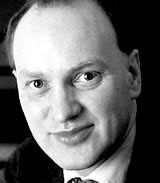Turn on – then tune out

Hundreds of channels and there’s nothing on, says Hugh Pearman. But even when he does tune in he gets little viewing pleasure in the ‘look’ of programmes
Another event to tick off in my diary: I’ve just finished not going to the Milan Furniture Fair again. That must be, ooh, the 15th year in succession that I have not been. I can add that to the dauntingly long list of other trade shows I’ve not been to in recent memory. Regular readers of this column know my aversion to such events. An aversion, I should add, that I would instantly overcome if someone offered me large wads of folding money to go.
How, you may ask, do I fill my hours when not attending all these events? Well, I can’t just sit around drumming my fingers and occasionally writing, so obviously I switch on what Jonathan Meades, with self-conscious retro-irony, calls ‘the telly’. Now that the University Challenge season has finished, the telly holds few attractions either. In fact, it contains disappointment after disappointment. And all of these disappointments are called documentaries.
What is it that has happened to documentaries? Of course, there are the occasional exceptions, like David Attenborough’s increasingly rare outings. Best to draw a veil over recent attempts to get design and architecture on what Meades probably also calls ‘the box’. Best also to draw a veil over the sinister Mr Meades’ own recent three-parter about British food, where his archly self-conscious style of presentation reminded us strangely of the otherwise long-forgotten James Burke (younger readers should be aware that Burke’s moment of fame as an exceedingly irritating BBC documentary-maker was in the early 1970s). I admire Meades’ attitude of bored superciliousness, but not his plodding attempts at surrealism.
I’m coming to the point of this – and it is to do with design. The design of the programmes themselves. By which I mean not just how they are constructed as narratives – the commonest faults being to spin out thin facts far too long, padding them out with mere speculation, and building up wholly artificial crises and cliff-hangers – but how they actually look.
The other week I foolishly turned on one of those ‘great moments in history’ programmes on BBC2. It dealt with the Wright Brothers’ first flight, and the first moon landing by astronauts. The look of the programme was stylised in the extreme, with whole chunks of it being put into a meaningless multi-part frame that acted as an almost physical screen between you and the picture. They got off to a bad start by using actors, though at least they had the sense not to have direct dialogue. But then they deliberately confused reality with fiction by keeping some of the acting sequences in 21st century colour, and putting others – with the same actors – in grainy, crackly, jerky monochrome as if to make out that this was archive film footage from 1903.
Once your suspicions had been aroused by that, you could not trust the authenticity of anything else. Those shots of Mission Control at Houston – archive footage or actors? We saw the chief mission controller coming out of his house, get into his Ford Mustang, and drive off to Nasa HQ. Clearly an acted sequence. But then the same bloke turns up in what looks very like a real piece of footage from the time. So that must be fake too, or at least some of it.
The same laziness happens elsewhere: for instance, clips from Eisenstein propaganda movies are commonly used as if they were real documentary film footage from the Russian Revolution.
What’s happening here is that nearly all of the attention of the producers is directed at the look of the documentary. Its surface sheen. If it looks pretty in some way – particularly if it is a graphic design prettiness – then that is thought to be enough. Content is secondary, and the rather crucial distinction between fact and fiction is ignored completely.
One of the ironies about the Wright Brothers’ story is that the official facts about their successful flight, which they telegraphed to their local paper, were spiked by that paper as being insufficiently interesting. Whereas a wildly embroidered and inaccurate version of the story, covertly arranged by the telegraph operator with his friend on another paper, was published to huge acclaim. That’s a parable for today’s documentary makers.
We often chortle at the crude title sequences of programmes from 20 or 30 years ago. We like to think we are more sophisticated. True, there is a lot of polish to the look of television today. The trouble is, polish is not enough. The worst documentaries are the ones that are over-designed. Which means that designers as well as producers are to blame.
Please email comments for publication i the Opinion section to lyndark@centaur.co.uk
-
Post a comment




